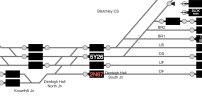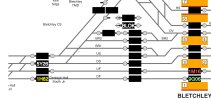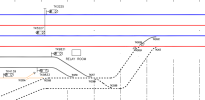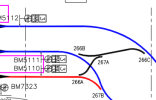For those of us not familiar with 350s, what damage is able to seen from the image?That'll be the last we see of that 350, can't see the ROSCO wanting to repair it straight away if it's going to sit in storage for ages.
-
Our new ticketing site is now live! Using either this or the original site (both powered by TrainSplit) helps support the running of the forum with every ticket purchase! Find out more and ask any questions/give us feedback in this thread!
You are using an out of date browser. It may not display this or other websites correctly.
You should upgrade or use an alternative browser.
You should upgrade or use an alternative browser.
Low-speed, empty stock derailment at Bletchley (26/06)
- Thread starter Vexed
- Start date
- Status
- Not open for further replies.
Sponsor Post - registered members do not see these adverts; click here to register, or click here to log in
R
RailUK Forums
That’s implying a person is involved in how it happened…….as we don’t know what has happened, or how, that is speculation.The location of the derailment not being a cross over between the US and DS can’t have helped either…
Someone has some explaining to do…
Freightmaster
Verified Rep
- Joined
- 7 Jul 2009
- Messages
- 3,859
That’s implying a person is involved in how it happened…….as we don’t know what has happened, or how, that is speculation.
While I agree that wild speculation is not always helpful, the thing that I find puzzling is that train left
platform 4 at Bletchley northbound on the up slow, a move which is not signalled, so the interlocking
should not have allowed the signal (TK9821) to be cleared in the first place.
The big question is whether the driver got verbal authorisation to pass that signal at danger
or whether there is an issue with the interlocking which allowed TK9821 to be cleared with
215 points set 'normal' for the up slow?
MARK
Tilting007
Member
Of course it can’t be confirmed until the full investigation is complete but it is clear and known and in the Control log a route was set through the points a crossover move is not possible through.That’s implying a person is involved in how it happened…….as we don’t know what has happened, or how, that is speculation.
== Doublepost prevention - post automatically merged: ==
It went that way instead of on the Relief 1 due to an incident last night affecting the points at the north end so it couldn’t be signalled normally that way.While I agree that wild speculation is not always helpful, the thing that I find puzzling is that train left
platform 4 at Bletchley northbound on the up slow, a move which is not signalled, so the interlocking
should not have allowed the signal (TK9821) to be cleared in the first place.
The big question is whether the driver got verbal authorisation to pass that signal at danger
or whether there is an issue with the interlocking which allowed TK9821 to be cleared with
215 points set 'normal' for the up slow?
MARK
Last edited:
james_the_xv
Member
Slightly speculative from my part but will likely need wheels/bogies overhauled on some of the vehicles due to forces exerted when running over ballast and sleeper. Given the 350/2s are going off lease anyway can't see it coming back.For those of us not familiar with 350s, what damage is able to seen from the image?
Lnwr would have to return the unit to leading the company in good working order , ie repaired.Slightly speculative from my part but will likely need wheels/bogies overhauled on some of the vehicles due to forces exerted when running over ballast and sleeper. Given the 350/2s are going off lease anyway can't see it coming back.
Liam L
Established Member
Id imagine the Rosco would want the unit back in working order though?That'll be the last we see of that 350, can't see the ROSCO wanting to repair it straight away if it's going to sit in storage for ages.
I recall 323214 which is owned by the same rosco and was with WMT was broken, was sent for repair, returned, used one day in service then went off lease.
From the aerial photograph on the BBC News website, it looks as if the route was set for the diverging route across the double junction (on the basis of flank locking). (This can be seen in the second photo - the point that is level with the first coach of the derailed unit: https://www.bbc.co.uk/news/articles/cn869nx605vo, and correlates with the way the point is set in the photo in post #42).
Assuming a switching diamond is present, that would suggest that the unit had been authorised to move across the junction in the trailing direction with the route set against it. This would have the inevitable consequence of derailing the unit when if found the switching diamond set for the route crossing its own. If that is the case, and without knowing the signalling at the location in detail, then there are three logical ways the move could have been authorised:
- by a signal (in which case the integrity of the interlocking is under the spotlight); or
- by being authorised to pass a signal that was (correctly) at danger, or
- by being authorised to make an unsignalled 'wrong-line' movement with the route incorrectly set.
As others have said the RAIB report will be interesting in understanding the primary and contributary causes - especially if it is true that there was another 'run-through' in the same general area only shortly before.
Assuming a switching diamond is present, that would suggest that the unit had been authorised to move across the junction in the trailing direction with the route set against it. This would have the inevitable consequence of derailing the unit when if found the switching diamond set for the route crossing its own. If that is the case, and without knowing the signalling at the location in detail, then there are three logical ways the move could have been authorised:
- by a signal (in which case the integrity of the interlocking is under the spotlight); or
- by being authorised to pass a signal that was (correctly) at danger, or
- by being authorised to make an unsignalled 'wrong-line' movement with the route incorrectly set.
As others have said the RAIB report will be interesting in understanding the primary and contributary causes - especially if it is true that there was another 'run-through' in the same general area only shortly before.
Last edited:
A little ironic that 350247 has a London midland golden spanner decal (see attached) considering the mess it has just caused.
View attachment 182691
Saying the unit is a "golden spanner" is probably quite fitting...
Sentinel
Member
It does seem odd that it derailed on the diamond (as per the BBC aerial photo) but the signalling shows it on the down slow which it never reached. Also the points from the down slow to the sidings in a previous post do appear to be switched to the sidings. This seems to indicate a conflict between the interlocking and an out of the ordinary approved movement. ment?
ment?
 ment?
ment?
Last edited:
alxndr
Established Member
- Joined
- 3 Apr 2015
- Messages
- 1,604
It left Bletchley wrong direction on the Up Slow.Wouldn't it have been more likely that the set had run south of Bletchley then used the signalled crossover to the down slow, stopped, changed ends, then run north on the down slow? The signalling attached shows it in such a position north of Bletchley. It could not have used a switched diamond to change from the up slow to the down slow; that is not the purpose of a switched diamond and is physically impossible. Does anyone know exactly where the back of the train was before this diamond and the derailment? And anyway, if it was to be a "non-signalled route", that would have been to reverse on the up slow back north through Bletchley and then take the signalled crossover (as used for north bound traffic from the sidings) across to the down slow. However the signalling snapshot shows that it didn't. I think the diamond is not relevant here; it never crossed it. I suggest that the train was on the down slow and came unstuck on the trailing points at the junction that included the diamond, probably due to a false flange that couldn't cope with the points.View attachment 182698ment?
Sentinel
Member
It left Bletchley wrong direction on the Up Slow.
== Doublepost prevention - post automatically merged: ==
Agreed, I have now seen the BBC aerial photo and edited my opinion accordingly.
From the initial photo and various descriptions above, it suggests the leading bogie encountered diamond elbows set against it and went over the top to land in the four foot between the US & DS. The second bogie looks to have followed the route of the elbows. Either or both impacts had sufficient force through the fittings and bearers to create the kink now seen on the DS.
Last edited:
Sentinel
Member
It seems strange that the train didn’t follow the fully signalled path north from Bletchley from the US along BR1, then through the double slip onto the DS. The photos of the points at the derailment seem to indicate that the latter part of this route was set, as does the screenshot of the head code on the signalling. Perhaps the signaller assumed the diamond at the derailment point was also a double slip, or he confused it with the double slip at the exit from BR1?


Tilting007
Member
As mentioned up thread, the route via BR1 was not possible due to the points at the North End on the Down Bletchley being out of use.It seems strange that the train didn’t follow the fully signalled path north from Bletchley from the US along BR1, then through the double slip onto the DS. The photos of the points at the derailment seem to indicate that the latter part of this route was set, as does the screenshot of the head code on the signalling. Perhaps the signaller assumed the diamond at the derailment point was also a double slip, or he confused it with the double slip at the exit from BR1?
View attachment 182702
Train is back on the rails this morning.
Sentinel
Member
ok, then that reinforces my theory that the signaller thought the diamond was a double slip.As mentioned up thread, the route via BR1 was not possible due to the points at the North End on the Down Bletchley being out of use.
Train is back on the rails this morning.
Nicholas Lewis
On Moderation
I doubt RAIB will undertake an investigation unless there is underlying issue with the signalling system. The other potential causes are related to how the various sections of the rulebook and local instructions have been applied which can be handled through a local investigation by the route team.From the aerial photograph on the BBC News website, it looks as if the route was set for the diverging route across the double junction (on the basis of flank locking). (This can be seen in the second photo - the point that is level with the first coach of the derailed unit: https://www.bbc.co.uk/news/articles/cn869nx605vo, and correlates with the way the point is set in the photo in post #42).
Assuming a switching diamond is present, that would suggest that the unit had been authorised to move across the junction in the trailing direction with the route set against it. This would have the inevitable consequence of derailing the unit when if found the switching diamond set for the route crossing its own. If that is the case, and without knowing the signalling at the location in detail, then there are three logical ways the move could have been authorised:
- by a signal (in which case the integrity of the interlocking is under the spotlight); or
- by being authorised to pass a signal that was (correctly) at danger, or
- by being authorised to make an unsignalled 'wrong-line' movement with the route incorrectly set.
As others have said the RAIB report will be interesting in understanding the primary and contributary causes - especially if it is true that there was another 'run-through' in the same general area only shortly before.
Tilting007
Member
That will depend on infrastructure damage and if trains can use the slow lines.I can see this is still causing significant disruption on the WCML today. Is there a good chance normal service will be resumed tomorrow?
== Doublepost prevention - post automatically merged: ==
They were on site yesterday to review the incident.I doubt RAIB will undertake an investigation unless there is underlying issue with the signalling system. The other potential causes are related to how the various sections of the rulebook and local instructions have been applied which can be handled through a local investigation by the route team.
Last edited:
NSEWonderer
Established Member
Not with the Buckling of track I saw in some photos, let alone the rerailing needed.I can see this is still causing significant disruption on the WCML today. Is there a good chance normal service will be resumed tomorrow?
A double or single slip is clearly indicated on signalling plans and the panel display as distinct from a diamond of either type. Here's Denbigh Hall South Jn on the old PSB: https://photos.signalling.org/picture?/11835/category/1151-bletchley_psb with the diamond (switched) clearly indicated and various single slips visible on the left of the diagram clearly distring from the diamonds.ok, then that reinforces my theory that the signaller thought the diamond was a double slip.
It's always possible, but it would be a very serious error from the signaller to not just forget a detail like that on an area they sign, but to misread or disregard the display.
Despite what traksy implies, the exit from BR1 is a set of back-to-back turnouts, not a double-slip. https://maps.app.goo.gl/7NDLa9ZDXJepg2Et5then through the double slip onto the DS. .. Perhaps the signaller assumed the diamond at the derailment point was also a double slip, or he confused it with the double slip at the exit from BR1?
In fact, looking at the whole Bletchely/Milton Keynes area signalling diagrams, there appears to not be any single or double slips at all (not a surprise, NR hate them) within the signalled area (my maps don't cover the sidings). The nearest set of slips to Bletchley appear to be at either Hemel or Northampton.
Two motors are visible on Google maps https://maps.app.goo.gl/p2KF6teX9ULaKs3h8, but in Signalling diagrams the two ends of the switched diamond are listed as TK262A and TK262B indicating they are controlled as a pair (the turnout on the down slow is also TK262C).I assume that a switchable diamond only has a single IPS (individual point switch)?
Apologies I'm not a signalling engineer so don't know if that answers your question.
Yes. I was expecting a single switch to operate the elbows as a pair and individual switches on a double slip to work each end independently.Two motors are visible on Google maps https://maps.app.goo.gl/p2KF6teX9ULaKs3h8, but in Signalling diagrams the two ends of the switched diamond are listed as TK262A and TK262B indicating they are controlled as a pair (the turnout on the down slow is also TK262C).
Apologies I'm not a signalling engineer so don't know if that answers your question.
Domino
New Member
This is an old Ariel photo, they used to have 3 individual HW2000 points machines to control each end (A,B, and C), however they are now a set of Voestalpine Unistars with a single pump unit on the A/B end, with IBCL on the C end. This was changed over easter bank holiday last year.Two motors are visible on Google maps https://maps.app.goo.gl/p2KF6teX9ULaKs3h8, but in Signalling diagrams the two ends of the switched diamond are listed as TK262A and TK262B indicating they are controlled as a pair (the turnout on the down slow is also TK262C).
Apologies I'm not a signalling engineer so don't know if that answers your question.
Yes, it looks like the two ends of double slips are worked independently (but both 'arms' at each end are worked together).Yes. I was expecting a single switch to operate the elbows as a pair and individual switches on a double slip to work each end independently.
For comparison, here's Denbigh Hall South Jn:

And here's a double slip at Birmingham New Street:

(Image description: 2 extracts from signalling diagrams showing the different depictions and point end numbering for a switched diamond at Denbigh Hall South Jn and a double slip at Birmingham New Street)
The regulations describe the following as immediately reportable:I doubt RAIB will undertake an investigation unless there is underlying issue with the signalling system. The other potential causes are related to how the various sections of the rulebook and local instructions have been applied which can be handled through a local investigation by the route team.
'A derailment of rolling stock on a running line that was open to railway traffic at the time of the derailment, or which blocks a running line that was open to railway traffic at the time of the derailment.'
'An accident or incident that is likely to result in suspension of a railway service for a period in excess of 6 hours.'
'An accident that causes extensive damage to rolling stock, the infrastructure or the environment.'
'
With regard to accident that RAIB are required to investigate, the regulations are as follows:
'(3) The Branch shall make the necessary arrangements to commence an investigation of an accident or incident—
(a)where the accident is a serious accident; or
(b)where it is not a serious accident but is an accident or incident which, under slightly different conditions, might have led to a serious accident and the Branch has determined that it will conduct an investigation,
within seven days of being notified of the accident or incident.'
Even if meeting the threshold for immediate reporting to RAIB on three counts did not result in an investigation under (3)(a), given that the derailment was on lines open to traffic and also resulted in obstructing two other running lines that were open to traffic (including lines with high line speeds), it is almost certain that an investigation would follow consequent to (3)(b). It is only good fortune of timing that there were no other trains on the running lines that became obstructed. If there had been a train running at line limits on either of the obstructed lines the secondary accident could have been of significant severity...
But why on earth is it being allowed to affect services today?
A couple of years ago, we took the train from Guayaquil to Quito and spent a lot of time in the open balcony car at the back. At one point this carriage derailed - it was very bumpy and unpleasant for a few seconds until the brakes were applied. I thought, based on British Rail practice, that it would take a day to fix it, but not at all.
The crew got a metal frame out of storage behind the loco and manhandled it on the track in front of the derailed wheels, used their radio to get the driver to move the train extremely slowly forwards, so the affected wheels slowly mounted the steel channel up over the rail and back down into place. So we got back under way in not much more than 30 minutes.
Admittedly, this was light rail, but surely there must be a fast way of getting a carriage back on the track?
A couple of years ago, we took the train from Guayaquil to Quito and spent a lot of time in the open balcony car at the back. At one point this carriage derailed - it was very bumpy and unpleasant for a few seconds until the brakes were applied. I thought, based on British Rail practice, that it would take a day to fix it, but not at all.
The crew got a metal frame out of storage behind the loco and manhandled it on the track in front of the derailed wheels, used their radio to get the driver to move the train extremely slowly forwards, so the affected wheels slowly mounted the steel channel up over the rail and back down into place. So we got back under way in not much more than 30 minutes.
Admittedly, this was light rail, but surely there must be a fast way of getting a carriage back on the track?
westcoaster
Established Member
Can you not recieve main plus the route onto R1.While I agree that wild speculation is not always helpful, the thing that I find puzzling is that train left
platform 4 at Bletchley northbound on the up slow, a move which is not signalled, so the interlocking
should not have allowed the signal (TK9821) to be cleared in the first place.
The big question is whether the driver got verbal authorisation to pass that signal at danger
or whether there is an issue with the interlocking which allowed TK9821 to be cleared with
215 points set 'normal' for the up slow?
MARK
== Doublepost prevention - post automatically merged: ==
Track looks quite out of place by the points. That's going to take some sorting.But why on earth is it being allowed to affect services today? I couple of years ago we took the train from Guayaquil to Quito and spent a lot of time in the open balcony car at the back. At one point this carriage derailed - it was very bumpy and unpleasant for a few seconds until the brakes were applied. I thought, based on British Rail practice, that it would take a day to fix it, but not at all. The crew got a metal frame out of storage behind the loco and manhandled it on the track in front of the derailed wheels, used their radio to get the driver to move the train extremely slowly forwards so the affected wheels slowly mounted the steel channel up over the rail and back down into place. So we got back under way in not much more than 30 minutes. Admittedly this was light rail, but surely there must be a fast way of getting a carriage back on the track?
They were re railed last night weren't they?But why on earth is it being allowed to affect services today? I couple of years ago we took the train from Guayaquil to Quito and spent a lot of time in the open balcony car at the back. At one point this carriage derailed - it was very bumpy and unpleasant for a few seconds until the brakes were applied. I thought, based on British Rail practice, that it would take a day to fix it, but not at all. The crew got a metal frame out of storage behind the loco and manhandled it on the track in front of the derailed wheels, used their radio to get the driver to move the train extremely slowly forwards so the affected wheels slowly mounted the steel channel up over the rail and back down into place. So we got back under way in not much more than 30 minutes. Admittedly this was light rail, but surely there must be a fast way of getting a carriage back on the track?
- Status
- Not open for further replies.
